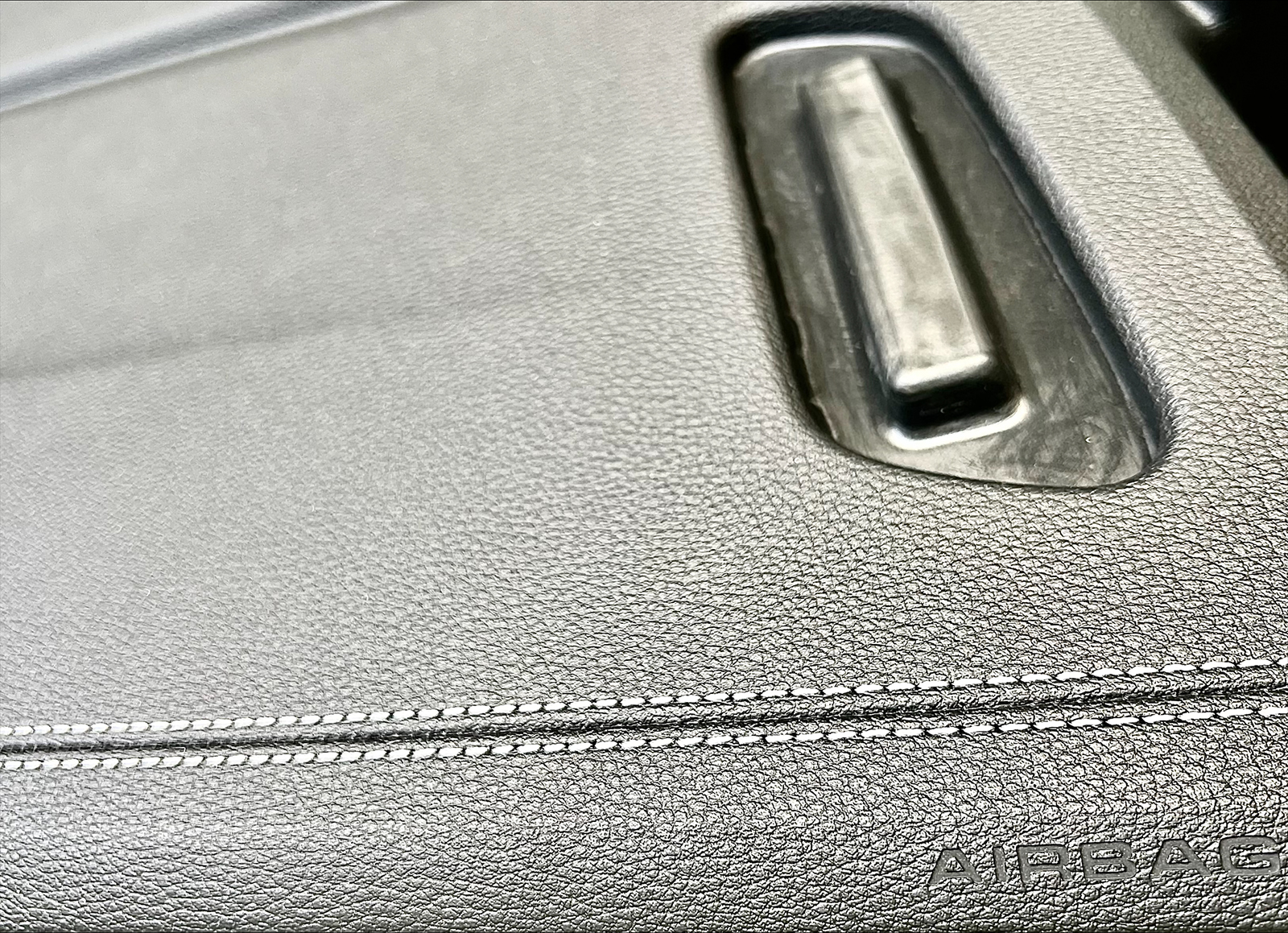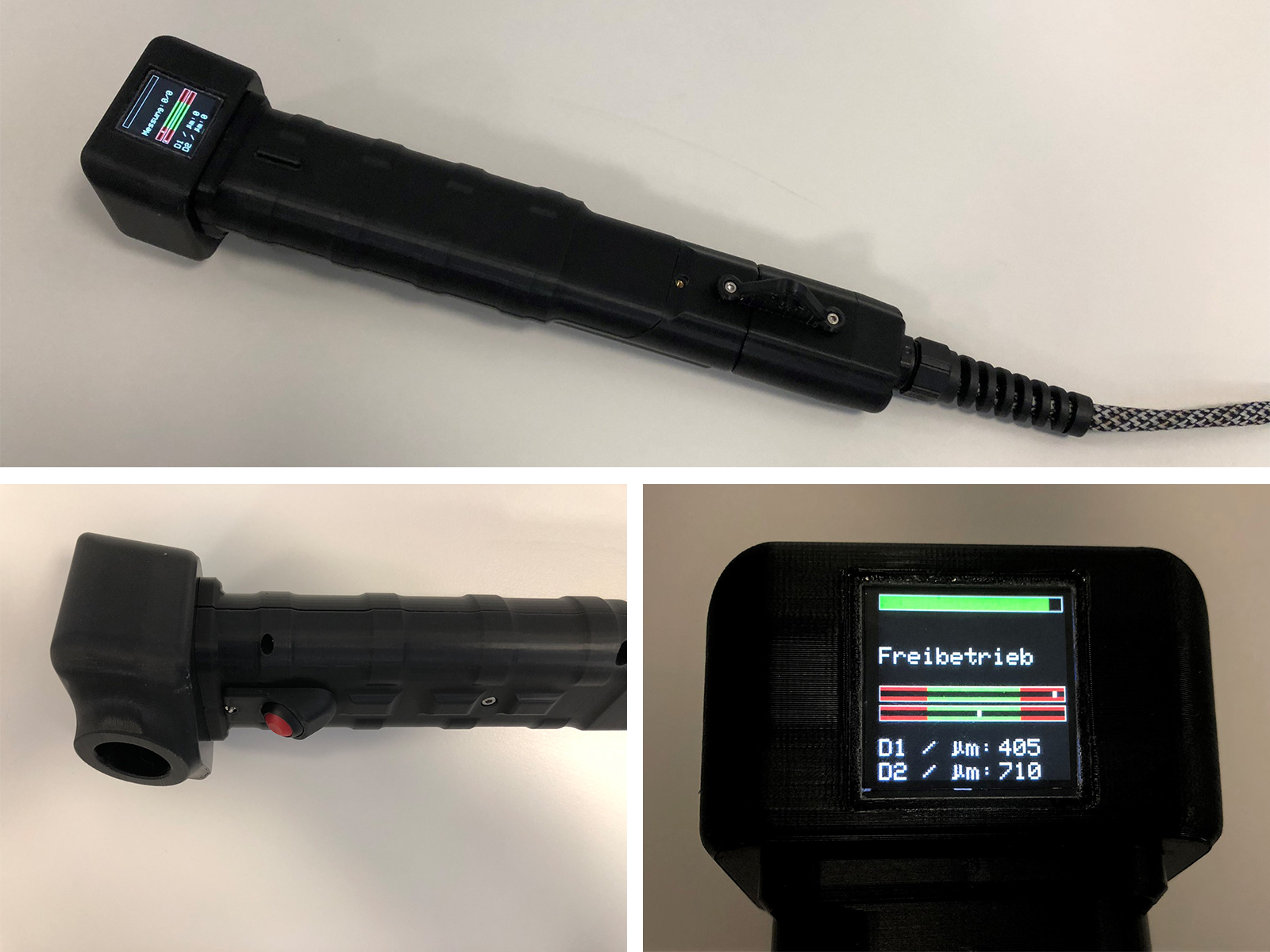Safe airbag deployment

Cross-section of a slush skin: For the airbag to deploy reliably, the predefined tear lines must extend right to the top layer.
© Fraunhofer ITWM
Terahertz measurement system for slush skins.
According to the Government Statistics Office, more than 358,000 people were injured in traffic accidents in Germany in 2022. Airbags often prevent more serious injuries. They are hidden behind a plastic panel called a slush skin. For the skin to tear open along the right lines, it is perforated meticulously after manufacture. For the airbag to fully deploy in an emergency, the material and the intended tear lines must be matched as closely as possible. To make sure this is the case, user-friendly technology is now used to inspect the slush skins: The Fraunhofer ITWM has developed a hand-held terahertz measurement system for individual, non-destructive quality control of slush skins.
Slush skins, with their look of leather, are used to cover dashboards in many mid-range and luxury vehicles. They have a very flexible design and feel and are also important when it comes to safety. The name comes from the manufacturing process of slush molding with slush powder: A hollow metal mold is first heated, then filled with plastic powder and swirled around. The powder begins to melt and stick and a continuous skin forms as it cools down.
Modern slush skins have an uneven structure and are made up of several layers, not just for the sake of appearance.
To save on weight and material, while at the same time making sure it attaches firmly to a vehicle’s interior, Antolin Straubing GmbH has developed a dual-layer system for slush skins. It was necessary to devise an in-process inspection procedure for the new product to ensure that the airbag will deploy through the slush skin in the event of a traffic accident and protect the vehicle’s occupants.
How can each slush skin be inspected individually?
The automotive supplier approached Fraunhofer ITWM with this problem. In keeping with new regulations, dual-layer slush skins can no longer be subject only to random inspection using microscopic analysis but must be examined individually in a non-destructive manner. With the Fraunhofer ITWM research team’s expertise in the field of measuring multi-layer paint thickness firmly in mind, the supplier got in touch with the Materials Characterization and Testing department. For the last few years, the Optical Terahertz Measurement Technology research team, under the direction of Dr. Daniel Molter, has been working on applications for terahertz technology in industry and has seen some promising results — for example, in the development of a reliable and non-destructive inspection process for painted surfaces in the automotive sector. This raises the question: Can terahertz measurement technology also be used on the uneven structure of slush skins to determine the thickness of both layers with some accuracy?
Measuring layer thickness using terahertz technology
Terahertz waves are electromagnetic waves between the microwave and infrared ranges and have a wavelength of around 300 microns. “Compared to technology relating to other parts of the spectrum, terahertz technology is relatively new and measuring layer thickness has turned out to be one of the most promising applications over the last few years,” says Molter, talking about the group’s field of research. “We use femtosecond lasers, and we convert the pulses into terahertz pulses by means of a photoconductive switch. This creates an electromagnetic pulse. This pulse is then aimed at a multiple layer system, which sends back an intermediate reflection at each layer transition — from air to the material under test, for instance, and then to a metal. The time difference between reflections allows conclusions to be drawn regarding the thickness of the individual layers, provided their optical properties are known.”
The technology previously used for evaluating the signals on systems with multiple layers of paint works reliably because this structure is homogeneous and boundary layers are well defined. To measure the uneven layers of slush skins, which also contain air bubbles, the researchers had to fine tune existing methodology. Instead of modeling the individual layer responses using mathematics, they worked with a series of filtering algorithms and the deconvolution of signals: Knowing one input variable (a reference signal or the system properties) and the output (measurement result), they were able to calculate the second input variable — namely, the layer pattern for the slush skin in question.
Mobile, hand-held measurement system
For the measurements to be taken directly on-site following production of the slush skins, the project group designed the new measuring system as a mobile trolley with a hand-held, 3D-printed measuring head. Along with specially developed software, it comes with an uninterruptible power supply, a touchscreen display with pull-out keyboard and a wireless barcode/QR scanner for product registration — and it is simple to operate. For quality control, the measuring head is placed at certain pre-defined points across the finished slush skin. If the measurement passes inspection, an acoustic signal is sent, and the layer thicknesses can be read at a glance on the display.
By successfully developing the measuring system for this very specific application, the group working with Molter has produced some pioneering work: “Despite our previous experience in measuring layer thicknesses, this project is unique because we had to address many customer-specific requirements.” Looking to the future, further possible applications are conceivable, from measuring other plastic layers in a vehicle’s interior to testing the thickness of pipe walls. “The system can generally be employed wherever wall thicknesses from around 10 microns up to a few millimeters need to be measured and a hand-held system is helpful,” says Molter. One thing is clear: In developing this terahertz inspection system, the research team has contributed to greater safety and sustainability in automobile manufacture.
Weitere Informationen:
https://www.fraunhofer.de/en/press/research-news/2023/august-2023/safe-airbag-de…
Media Contact
All latest news from the category: Materials Sciences
Materials management deals with the research, development, manufacturing and processing of raw and industrial materials. Key aspects here are biological and medical issues, which play an increasingly important role in this field.
innovations-report offers in-depth articles related to the development and application of materials and the structure and properties of new materials.
Newest articles
Faster, more energy-efficient way to manufacture an industrially important chemical
Zirconium combined with silicon nitride enhances the conversion of propane — present in natural gas — needed to create in-demand plastic, polypropylene. Polypropylene is a common type of plastic found…

Energy planning in Ghana as a role model for the world
Improving the resilience of energy systems in the Global South. What criteria should we use to better plan for resilient energy systems? How do socio-economic, technical and climate change related…

Artificial blood vessels could improve heart bypass outcomes
Artificial blood vessels could improve heart bypass outcomes. 3D-printed blood vessels, which closely mimic the properties of human veins, could transform the treatment of cardiovascular diseases. Strong, flexible, gel-like tubes…






















